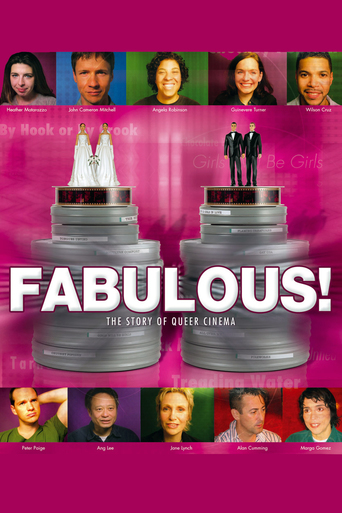meaninglessbark
Fabulous! will be most interesting to people who have no knowledge of queer films. Anyone who already has a semi-decent working knowledge of queer films will probably find Fabulous! to be an OK choice to watch/listen to while going through a pile of unsorted mail. Anyone hoping to find information about films they've never heard of will probably be disappointed.Fabulous! does a good job including many films that could be tagged L, G, B, T, and Q though it quickly passes over or neglects some that seem like they'd have a bigger role in a documentary like this. There are a lot of interviews with makers and supporters of queer cinema. Actually it's essentially all interviews, Fabulous! is a talking head film with a few clips thrown in here and there. Some of the interviews, especially those with queer actors, offer little more than "Oh my god, I loved (insert queer film title here)!".Ironically for a film about film Fabulous! could have been just as effective as radio documentary because it's not a film you really need to watch to get anything from. Most the time you're just staring at someone's face as he or she talks. Every now and then the talking heads are interrupted by a clip, still shot, timeline of 20th century gay history, or montage of queer film titles. The words and still images are thrown on the screen so briefly you can barely read anything or take in the images.Over all Fabulous! (a terrible gay cliché title that doesn't describe all queer films) feels like a promotional film for a film fest, queer TV channel, or DVD rental service...Which it just might be as Netflix was somehow involved int the production.
jaibo
This is a very disappointing documentary purporting to cover the history of gay representation in cinema but lacking focus. The film zips quickly from Anger's Fireworks to films produced in the late 1960s, without a mention of the upfront art cinema and sub-textual mainstream films produced in-between. Instead we get supposed "experts" in the subject who don't appear to know what they are talking about - B Ruby Rich seems under the misapprehension that Jarman and Fassbinder were making films pre-Stonewall.After this barely credible preamble, the film settles down to talking about the series of New Queer Cinema films which were produced in the early 1990s. Many of these are important films, but the slant here is very US-centric and the discussion is rarely rises above the anecdotal. The story then zips forwards to a very uncritical look at how gay cinema has begun producing happy, shiny DVD fodder for middle-class audiences; it isn't surprising that Bruce LaBruce doesn't get a name-check! Nearly all of the talking heads here (with the exception of the great John Waters) cry out for a queer version of mainstream cinema; it would have been nice to have some dissenting voices. It would also have been nice to have a debate around a film like Basic Instinct - gay critic Camille Paglia loved the film but is airbrushed from the version of events presented here.The bias of the film gives the lie to the cry at the end for a pluralistic gay cinema; on this evidence, most of the people here hail from a very narrow, middle-class American background and most of them want a very anodyne, US-oriented gay cinema. This makes the film feel cliquey and a massive missed opportunity.
lastliberal
For someone who is not familiar with the history of gay and lesbian cinema, this was an outstanding introduction to the subject.I was fascinated with the early "gay" films and the fact that they were basically pictures of muscle men. I can imagine the Governator in some of these films.What was significant and more important than the lack of films was the fact that gay and lesbian youth did not have any role-models to tell them that they were OK in how they felt. How many suicides resulted in a lack of gay films and gay actors on television? Taking us through the early days to today and thinking about the future of gay and lesbian films, it was an eyeopening experience and a must see for anyone interested in cinema history.
Edgar Soberon Torchia
If this film were called "The Story of American Queer Cinema" I would give it a higher rating, although --as it has been written in other reviews-- it only covers a small sample of its subject in American cinema, mostly independent films from recent years. It is neither a work on self-representation by American gay independent filmmakers, since it also covers a few motion pictures made by heterosexual directors, who --with varying degrees of respect-- have worked with homosexual or lesbian stories and characters. The lack of references to significant mainstream titles as "Mikaël" (1924), "Mädchen in Uniform" (1931) and the very bad "The Third Sex" (1957), the three being from Germany, the interesting British drama "Victim' (1961), Fassbinder's "Fox and His Friends" (1975), "The Best Way to Walk" (1976) and "The Wounded Man" (1983) from France, the Mexican black comedy "Doña Herlinda and Her Son" (1985), or Wong Kar-Wai's dramatic "Happy Together" (1997), omits the different and many aspects of what it means to be homosexual or lesbian in other cultures, so we are left with what it means to be "gay" or "queer", one-dimensional terms that many persons from all over the world (including myself) seem reluctant to apply to themselves or anyone. In the end this omission affects the work, making it appear too light and shallow in terms of world contribution to cinematic representation of same-sex eroticism, even when a few of the testimonies and analysis of a couple of motion pictures make the documentary moderately interesting.

